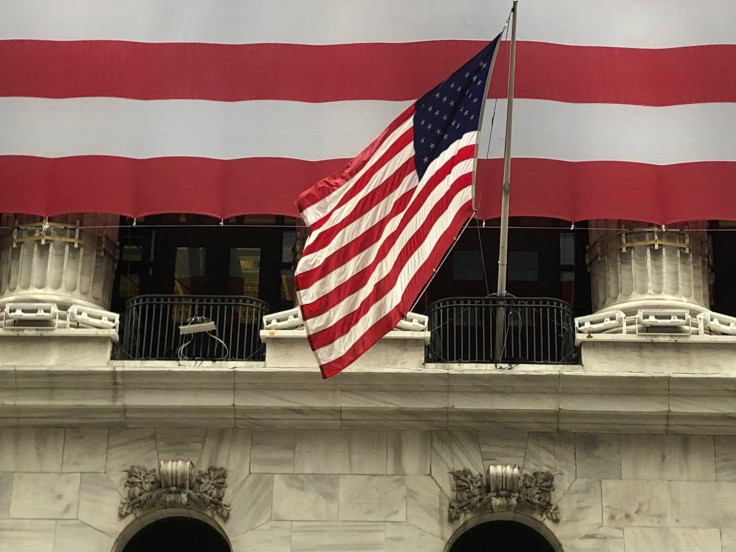Friday’s Stock Market Close: US Equities Edge Higher In Volatile Trading Despite Grim Retail Sales Data

KEY POINTS
- Retail sales plunged by a record 16.4% in April
- The Federal Reserve said its industrial production index plunged by a record 11.2% in April
- Industry capacity came in at 64.9%, another record low
U.S. stocks closed modestly higher on Friday on volatile trading despite a historic plunge in April retail sales and renewed trade tensions between U.S. and China.
The Dow Jones Industrial Average rose 60.08 points to 23,685.42, while the S&P 500 gained 11.2 points to 2,863.70 and the Nasdaq Composite Index advanced 70.84 points to 9,014.56.
Friday’s volume on the New York Stock Exchange totaled 4.22 billion shares with 1,612 issues advancing, 29 setting new highs, and 1,330 declining, with 16 setting new lows .
Active movers were led by Sorrento Therapeutics Inc. (SRNE) , General Electric Co. (GE) and Aurora Cannabis Inc. (ACB)
Retail sales plunged by a record 16.4% in April.
Sales at clothing and accessories stores plunged by 78.8%; restaurants and bars saw a 29.5% drop; and grocery stores lost 13.2% in sales.
Also, sales at department stores tumbled 28.9%, while furniture stores suffered a 58.7% drop. Auto and auto parts sales sank 12.4% and gas sales declined 28.8%. But online retailers witnessed an 8.4% gain in sales.
"Anxiety and fear are very strong emotions and consumer behavior may take time to adjust," wrote Jack Kleinhenz, chief economist at the National Retail Federation.
“Retail sales already saw their sharpest monthly fall on record in March but, with lockdown measures only coming in during the second half of the month, sales are set to fall even further in April,” Michael Pearce, senior U.S. economist at Capital Economics wrote on May 8.
The Federal Reserve said Friday that its industrial production index plunged by a record 11.2% in April. Manufacturing output dropped by 13.7% -- as production of cars, trucks and auto parts cratered by more than 70%.
Industry capacity came in at 64.9%, another record low. Factory capacity utilization fell to an all-time low of 61.1%.
But the University of Michigan’s consumer sentiment index unexpectedly rose to 73.7 in May, up from 71.8 in April.
“The [Coronavirus Aid, Relief, and Economic Security Act] relief checks improved consumers’ finances and widespread price discounting boosted their buying attitudes,” said Richard Curtin, chief economist for the Surveys of Consumers.
The New York Fed’s Empire State business conditions index rose by 29.7 points to minus-48.5 in May -- the second lowest reading on record.
The Trump administration has moved to block semiconductor shipments by global chipmakers to Huawei Technologies of China. The Commerce Department also said it will “strategically target Huawei’s acquisition of semiconductors that are the direct product of certain U.S. software and technology.” In turn, China warned it would retaliate against U.S. tech firms.
“This is not an ideal time to be ratcheting up the trade war with China,” said Randy Frederick, vice president of trading and derivatives at Charles Schwab. “I don’t really quite understand what the rationale is there. Clearly, the [Trump] administration wants to see the market do better, but the things they’re doing with China right now are making it worse.”
More than 4.4 million coronavirus cases have been confirmed around the world, with more than 1.4 million in the U.S.
“Given the amount of uncertainty about this [virus] crisis that still looms, we should not be surprised by the setbacks we’ve seen in markets this week,” said Scott Knapp, chief market strategist at CUNA Mutual Group.
Overnight in Asia, markets were mixed. The Shanghai Composite edged down 0.07%; Hong Kong’s Hang Seng slipped 0.14%; while Japan’s Nikkei-225 rose 0.62%.
In Europe markets closed higher, as Britain’s FTSE-100 gained 1.01%, while France’s CAC-40 edged up 0.11% and Germany’s DAX rose 1.24%.
Crude oil futures jumped 7.22% at $29.55 per barrel, Brent crude rose 0.65% at $32.71. Gold futures climbed 0.75%.
The euro edged up 0.08% at $1.0816 while the pound sterling slipped 0.94% at $1.2116.
The yield on the 10-year Treasury gained 3.39% to 0.64% while yield on the 30-year Treasury rose 1.77% to 1.319%.
© Copyright IBTimes 2025. All rights reserved.





















